arizona
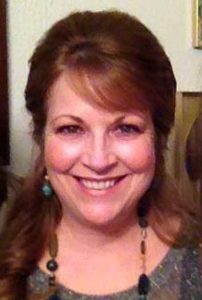
 My sister, Allyn Hadlock has had quite an unusual year. Allyn has worked at Wyoming Medical Center (now Banner Health) for twenty years now. She is the Senior Manager of the PFS Billing Unit. She is well liked and works hard, but with so many changes in the working world since Covid happened, Allyn has really had working from home on her heart. At first, it seemed like an impossibility, but when Banner purchased WMC, the idea surfaced again…both in my sister’s mind, and thankfully in the minds of the new owners. So, on Monday, December 12, 2022, Allyn went home to work!!! It was a dream come true.
My sister, Allyn Hadlock has had quite an unusual year. Allyn has worked at Wyoming Medical Center (now Banner Health) for twenty years now. She is the Senior Manager of the PFS Billing Unit. She is well liked and works hard, but with so many changes in the working world since Covid happened, Allyn has really had working from home on her heart. At first, it seemed like an impossibility, but when Banner purchased WMC, the idea surfaced again…both in my sister’s mind, and thankfully in the minds of the new owners. So, on Monday, December 12, 2022, Allyn went home to work!!! It was a dream come true.
Allyn and her husband Chris Hadlock had inherited his parents’ property on the Platte River after his mom passed away a few years ago, and they removed the old house that was there and in pretty bad shape. Then, they had a brand-new home built there. The home was finished a few years ago, except for the unfinished attic. They had a bed up there for when their kids came to stay, but the rest of the 
 attic was open. Now, it is all finished, complete with a really nice guest suite, a sitting area, and two offices. Chris doesn’t work from home most of the time, but sometimes he does. Allyn, however, simply wakes up, has her breakfast and gets ready for her day. Then she and her dog, Liberty go upstairs for the day. She painted her office in her favorite color…yellow, and she has all her favorite things in there. Nevertheless, when she is in the office during working hours, she is all business.
attic was open. Now, it is all finished, complete with a really nice guest suite, a sitting area, and two offices. Chris doesn’t work from home most of the time, but sometimes he does. Allyn, however, simply wakes up, has her breakfast and gets ready for her day. Then she and her dog, Liberty go upstairs for the day. She painted her office in her favorite color…yellow, and she has all her favorite things in there. Nevertheless, when she is in the office during working hours, she is all business.
This year found Allyn making two trips to Arizona. In November, she went to Phoenix on a work trip. Of course, we were all jealous, because it was really cold here in Wyoming, and she got to take almost a week and go be in the warmth. It was a working trip, but she learned a lot, and the trip was very successful. Then, at the end of December, Allyn and Chris got to join daughter, Lindsay Moore; Lindsay’s husband, Shannon; and daughter, Mackenzie; as 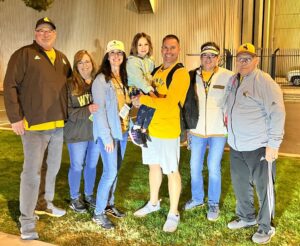
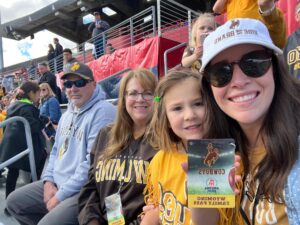 well as Shannon’s parents, Mary Jo and Tom Moore, in Tucson, Arizona for the Arizona Bowl game. Shannon is one of the coaches of the Cowboys. The team had won a spot in the game. Unfortunately, after a hard-fought game, the Cowboys lost, but the Hadlock/Moore families had an amazing time, and for the second time this winter, Allyn got to escape the cold in sunny Arizona. Today is Allyn’s 60th birthday. Happy birthday Allyn!! Have a great day!! We love you!!
well as Shannon’s parents, Mary Jo and Tom Moore, in Tucson, Arizona for the Arizona Bowl game. Shannon is one of the coaches of the Cowboys. The team had won a spot in the game. Unfortunately, after a hard-fought game, the Cowboys lost, but the Hadlock/Moore families had an amazing time, and for the second time this winter, Allyn got to escape the cold in sunny Arizona. Today is Allyn’s 60th birthday. Happy birthday Allyn!! Have a great day!! We love you!!

 Arizona…home of the Grand Canyon and Monument Valley, is famous for its red dirt and colorful formations, but these places aren’t the only famous places in the area. In fact, the Canyon de Chelly National Monument, which is located in Apache County, Arizona, and is in the current day Navajo Nation, is one of the most visited national monuments in the United States. The strange thing is that there are many people who have never heard of it…me included, and I have been to the Four Corners region. I guess that at the time my family went there, the Four Corners (the spot where four states meet) was more interesting to us. Or maybe it was that we were headed to the Grand Canyon. Anyway, I had not heard of the Canyon de Chelly. My older sister, Cheryl Masterson might find that amusing, and might even tell me that we have been there, but for some reason, if we have been there, I don’t recall.
Arizona…home of the Grand Canyon and Monument Valley, is famous for its red dirt and colorful formations, but these places aren’t the only famous places in the area. In fact, the Canyon de Chelly National Monument, which is located in Apache County, Arizona, and is in the current day Navajo Nation, is one of the most visited national monuments in the United States. The strange thing is that there are many people who have never heard of it…me included, and I have been to the Four Corners region. I guess that at the time my family went there, the Four Corners (the spot where four states meet) was more interesting to us. Or maybe it was that we were headed to the Grand Canyon. Anyway, I had not heard of the Canyon de Chelly. My older sister, Cheryl Masterson might find that amusing, and might even tell me that we have been there, but for some reason, if we have been there, I don’t recall.
The name, Canyon de Chelly is an unusual name for the United States, even in the Southwest. It sounds a bit French, but in reality, it is universal Spanish. “Chelly” is actually derived from the Navajo word tseg, which means “rock canyon” or “in a canyon.” Spanish explorers and government officials began to utilize a “Chelly,” “Chegui,” and even “Chelle” in order to try to replicate the Navajo word in the early 1800s. Eventually, the name was standardized to “de Chelly” by the middle of the 19th century. It is thought that the canyons of de Chelly contain the artifacts and homes of Native Americans as far back as 5,000 years. At first, they lived in caves and the only real evidence of their existence is the hieroglyphics etched into the red rock walls. These people were more nomadic, and so only visited the canyons while on hunting expeditions.
Later the people who lived there were more established, and so began the period of time when the adobe structures were formed. I think that anyone who has seen adobe home, in pictures or in person would have to admit that they are very interesting. It seems so amazing to me that these people could not only make a structure that could withstand the elements as well as these structures have, but to build them on the face of the cliffs is even more amazing. Adobe, of course, is a type of construction material made from a mixture of mud, straw, and water. It is commonly used in hot, dry climates, such as in the southwestern United States. Like any home, renovation took place over the years, strengthening and changing the structures. The structures have names such as Standing Cow (named for the hieroglyphic white bull on the wall above the home), white house (so named because of a white wall in the back of the structure), Mummy Cave (I don’t believe any mummies were found there, so I’m not sure how it got its name), and Antelope House (named for the hieroglyphic carvings of antelope above it). The homes in Canyon de Chelly were abandoned around 1300, although no one really knows why. Over the past century, archaeologists, historians, and scientists have tried to pinpoint the root causes of the massive abandonment of settlements like Hovenweep, Chaco Canyon, and Mesa Verde, but there is no single consensus among experts. It might have been due to warfare, severe drought, food shortages, infectious diseases, or the emergence of new religious and cultural centers. Whatever the 
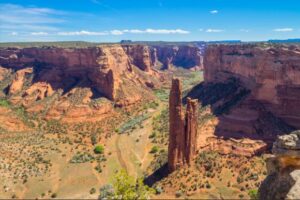 reasons, Canyon de Chelly’s people left the area and migrated south toward the more fertile Rio Grande Valley in present-day New Mexico or toward the Little Colorado River Basin in what is present-day Arizona. That is known because of the homes built in the same fashion in the Pueblos of New Mexico, the Zuni, and the Hopi Indian areas, where the structures still have the rich traditions in artistic and architectural design.
reasons, Canyon de Chelly’s people left the area and migrated south toward the more fertile Rio Grande Valley in present-day New Mexico or toward the Little Colorado River Basin in what is present-day Arizona. That is known because of the homes built in the same fashion in the Pueblos of New Mexico, the Zuni, and the Hopi Indian areas, where the structures still have the rich traditions in artistic and architectural design.
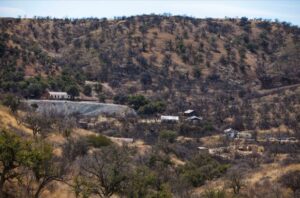
 Lots of mining towns started out when someone discovered gold, silver, or some other precious metal. A few of them have continued to produce enough “treasure” to maintain and even rapidly grow a town. Others fizzled in a short time, or even a long time, but when the mines dried up, the towns went with them. Because of that, there are numerous ghost towns that dot the United States…and probably other nations too.
Lots of mining towns started out when someone discovered gold, silver, or some other precious metal. A few of them have continued to produce enough “treasure” to maintain and even rapidly grow a town. Others fizzled in a short time, or even a long time, but when the mines dried up, the towns went with them. Because of that, there are numerous ghost towns that dot the United States…and probably other nations too.
Ruby, Arizona is a ghost town in very near the Arizona-Mexico border. It is one of the best-preserved ghost towns in the state. In the 1700s, rich minerals were discovered there by the Spaniards, but they were not rich enough for their tastes, so only a limited amount of placer mining occurred before they moved on, leaving the area largely undisturbed for nearly a century, until two mining engineers, Chares Poston and Henry Ehrenberg, 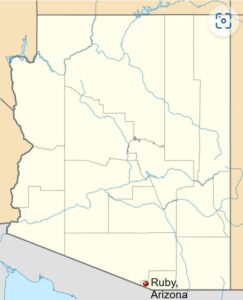 revived the old Spanish placers in Montana Gulch in 1854. With the discovery of rich veins of gold and silver, which the Spaniards had somehow missed, came other prospectors looking for their own rich strike. While the area was rich in gold and silver, it also had Apache Indians, and they were…hostile, to say the least.
revived the old Spanish placers in Montana Gulch in 1854. With the discovery of rich veins of gold and silver, which the Spaniards had somehow missed, came other prospectors looking for their own rich strike. While the area was rich in gold and silver, it also had Apache Indians, and they were…hostile, to say the least.
Nevertheless, mining did proceed starting around 1877. Ruby, Arizona was founded as a mining town in Bear Valley, originally named Montana Camp. It was so named because the miners were mining at the foot of Montana Peak. The Montana mine produced gold, silver, lead, zinc, and copper…peaking in the mid-1930s. While never a large town, Ruby had a population of about 1,200 people. The post office was established on April 11, 1912, by the mining camp’s general store, Julius Andrews. When Andrews named the post office “Ruby,” after his wife, Lille B Ruby Andrews, and the mining camp became known as Ruby. The post office closed on May 31, 1941.
The town of Ruby has been through some wild times, and never was that more evident than the years between 1920 and 1922, when the town and the area surrounding Ruby was the scene of three double homicides known as the Ruby Murders. The largest manhunt in the history of the Southwest followed the crimes, and it included the first airplane ever used in an Arizona manhunt. The town’s most prosperous period was in the late 1920s 
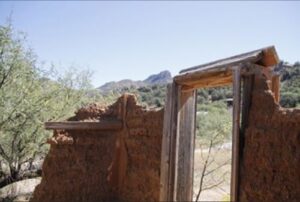 and 1930s, when the Eagle-Picher Mining Company operated the mine. They also upgraded the camp. The Montana mine was the leading lead and zinc producer in Arizona from 1934 to 1937. In 1936, it was third in silver production. Nevertheless, it seems, in mining anyway, that “all good things must come to an end” and so it was with the mine, which closed in 1940. By the end of 1941 Ruby was abandoned.
and 1930s, when the Eagle-Picher Mining Company operated the mine. They also upgraded the camp. The Montana mine was the leading lead and zinc producer in Arizona from 1934 to 1937. In 1936, it was third in silver production. Nevertheless, it seems, in mining anyway, that “all good things must come to an end” and so it was with the mine, which closed in 1940. By the end of 1941 Ruby was abandoned.
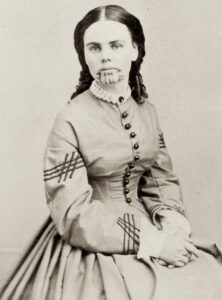
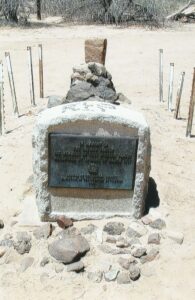 Mary Ann and Royce Oatman had seven children, and Mary Ann was pregnant with their eighth child in 1851, when she and Royce decided to move their family the Gila River area of California. The Oatman children ranged in age from one to 17, the eldest being Lucy Oatman. The family has only been on the trail for four days from their starting point if Maricopa Wells, when they were approached by a group of Native Americans who were asking for tobacco and food. Royce Oatman was hesitant to share too much with the small band of Yavapais, because of the lack of supplies. The Yavapaus saw this as stinginess, and became irate. The Yavapais attacked the Oatman family…clubbing them to death. All were killed except for three of the children. Lorenzo, who was 15 years old was left for dead, and 14-year-old Olive and 7-year-old Mary Ann, who were taken to be slaves for the Yavapais.
Mary Ann and Royce Oatman had seven children, and Mary Ann was pregnant with their eighth child in 1851, when she and Royce decided to move their family the Gila River area of California. The Oatman children ranged in age from one to 17, the eldest being Lucy Oatman. The family has only been on the trail for four days from their starting point if Maricopa Wells, when they were approached by a group of Native Americans who were asking for tobacco and food. Royce Oatman was hesitant to share too much with the small band of Yavapais, because of the lack of supplies. The Yavapaus saw this as stinginess, and became irate. The Yavapais attacked the Oatman family…clubbing them to death. All were killed except for three of the children. Lorenzo, who was 15 years old was left for dead, and 14-year-old Olive and 7-year-old Mary Ann, who were taken to be slaves for the Yavapais.
When Lorenzo woke up after the attack, he found his parents and most of his siblings dead, but he saw no sign of little Mary Ann or Olive. With great effort, Lorenzo made the hazardous trek to find help. He eventually reached a settlement, where his wounds were treated. When he had recovered, Lorenzo rejoined the emigrant train. Three days later the train reached the bodies of his slain family. The story was told far and wide In great detail in newspapers over the decades. Lorenzo said, “We buried the bodies of father, mother and babe in one common grave.” The men had no way of digging proper graves in the volcanic rocky soil, so they gathered the bodies together and formed a cairn over them. It has been said the remains were reburied several times and finally moved to the river for re-interment by early Arizona colonizer Charles Poston. I’m sure that was a source of relief for Lorenzo. He refused to give up hope that his sisters were alive. He determined never to give up the search for his only surviving siblings.
Olive and Mary Ann were held captive for one year by the Yavapais before they were traded to the Mohave people. Lorenzo was in the process of exhaustively attempting to recruit governmental help in searching for his sisters. The trade for the girls was initiated by the Mohave people. At first, the Yavapais refused, but the Mohave Chief Espaniole saw the girls and their poor treatment during a trading expedition. He tried to make a trade for the girls. The Yavapais refused, but the chief’s daughter, Topeka, was persistent and returned once more offering a trade for the girls. Eventually the Yavapais gave in and traded the girls for two horses, some vegetables, blankets, and beads. At some point after the girls went to be with the Mohave people, Mary Ann died from starvation. This happened in about 1855–1856, when Mary Ann was ten or eleven. It has been claimed that there was a drought in the region, and that the tribe experienced a dire shortage of food supplies. Olive would have died too, had not Aespaneo, the matriarch of the tribe, saved her life by making a gruel to sustain her.
Olive was left alone with the Mohave people for about four years. This was not the worst time in their captivity. The Mohave people tattooed the girls chins and arms, which was not a marking of a slave, but rather of family. The also told Olive that she could go to the village of the white people if she wanted, but they dared not go with her, because they feared for their lives for having kept her for so long. I suppose, she didn’t know anyone in that village either, so why go.
When Olive was 19 years old, Francisco, a Yuma Indian messenger, arrived at the village with a message from the authorities at Fort Yuma. They had heard that a white girl was living with the Mohaves, and the post commander requested her return, or to know the reason why she did not choose to return. The Mohave tried to resist, but after some discussion, in which Olive was included, the Mohaves decided to accept these terms, and Olive was escorted to Fort Yuma in a 20-day journey. Topeka (the daughter of Espianola and Aespaneo) went on the journey with her. Before entering the fort, Olive was given Western clothing lent by the wife of an army officer, as she was wearing a traditional Mohave skirt with no covering above her waist. Inside the fort, Olive was surrounded by cheering people. I wonder if she felt like cheering…or crying. Olive’s childhood friend Susan Thompson, whom she befriended again at this time, stated many years later that she believed Olive was “grieving” upon her return because she had been married to a Mohave man and had given birth to two boys. Of course, there is no record to substantiate that claim.
In November 1865, Olive Oatman married a cattleman named John B. Fairchild. They met at a lecture she was giving alongside in Michigan. Fairchild had lost his brother to an attack by Native Americans during a cattle drive in Arizona in 1854, the time in which Oatman was living among the Mohave. Olive began wearing a veil to cover her famous tattoo and became involved in charity work. She was particularly interested in helping a local 
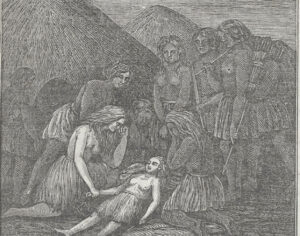 orphanage. She and Fairchild never had their own children, but they did adopt a little girl and named her Mary Elizabeth after their mothers, nicknaming her Mamie.
orphanage. She and Fairchild never had their own children, but they did adopt a little girl and named her Mary Elizabeth after their mothers, nicknaming her Mamie.
Olive’s brother, Lorenzo died on October 8, 1901. Less than 2 years, Olive Oatman Fairchild died of a heart attack on March 20, 1903, at the age of 65. She is buried at the West Hill Cemetery in Sherman, Texas.
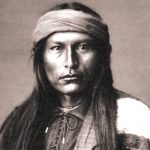 We always think of the wars between the Indians and the White Man being disputes between the two parties over land, and often they were, but sometimes it is something else altogether, and sometimes it is simply ad devastatingly, a mistake. As with many Indians of the early years of our country, not much was known about Chief Cochise’s early life, but he was hailed as one of the great leaders of the Apache Indians. He took them into many battles between his people and the people of southern Arizona and northern Mexico, who he felt were pushing his people off of their lands. Like many other Chiricahua Apache, Cochise resented the encroachment of Mexican and American settlers on their traditional lands. They felt like they had been pushed back and they were tired of it. Cochise began to lead many raids on the settlers living on both sides of the border. The raids caused Mexicans and Americans alike start calling for military aid.
We always think of the wars between the Indians and the White Man being disputes between the two parties over land, and often they were, but sometimes it is something else altogether, and sometimes it is simply ad devastatingly, a mistake. As with many Indians of the early years of our country, not much was known about Chief Cochise’s early life, but he was hailed as one of the great leaders of the Apache Indians. He took them into many battles between his people and the people of southern Arizona and northern Mexico, who he felt were pushing his people off of their lands. Like many other Chiricahua Apache, Cochise resented the encroachment of Mexican and American settlers on their traditional lands. They felt like they had been pushed back and they were tired of it. Cochise began to lead many raids on the settlers living on both sides of the border. The raids caused Mexicans and Americans alike start calling for military aid.
While those raids resulted in deaths and retribution, there was a war that was started for a completely different reason…a misunderstanding. In October 1860, a band of Apache attacked the ranch of John Ward, who was an Irish-American. The Apache kidnapped Ward’s adopted son, Felix Telles. Ward was not home at the time, and while he had no confirmation, he was convinced that Cochise was the leader of the raid. Ward demanded that the US Army go out to rescue his son and bring Cochise to justice. Of course, the Army mobilized immediately, under the command of Lieutenant George Bascom.
Cochise had no idea that they were in any danger, when they received Bascom’s invitation to join him for a night of entertainment at a nearby stage station. I suppose that is was a peaceful way to arrest the warriors, 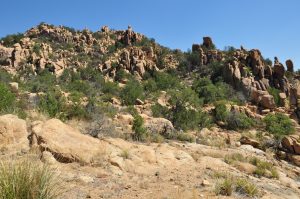 but it seems so unscrupulous now. Still, I guess no one died that night. When the Apache arrived, Bascom’s soldiers arrested them. Cochise told Bascom that he was innocent of the kidnapping of Felix Telles, but the lieutenant refused to believe him. Bascom decided that Cochise would be kept in confinement until the boy was returned, thinking that his warriors would relent and give up the boy to get their chief back, but Cochise had other ideas. Cochise determined that he would not tolerate being imprisoned unjustly. He used his knife to cut his way out of the tent where he was being held and escaped. They did not recapture Cochise, and the boy was not returned.
but it seems so unscrupulous now. Still, I guess no one died that night. When the Apache arrived, Bascom’s soldiers arrested them. Cochise told Bascom that he was innocent of the kidnapping of Felix Telles, but the lieutenant refused to believe him. Bascom decided that Cochise would be kept in confinement until the boy was returned, thinking that his warriors would relent and give up the boy to get their chief back, but Cochise had other ideas. Cochise determined that he would not tolerate being imprisoned unjustly. He used his knife to cut his way out of the tent where he was being held and escaped. They did not recapture Cochise, and the boy was not returned.
The raids continued and increased in severity over the next decade. Cochise and his warriors also fought occasional skirmishes with soldiers. The unrest started a panic among the settlers, and they began to abandon their homes. The Apache raids took hundreds of lives and caused hundreds of thousands of dollars in property damages. As time went on the US government was desperate for peace by 1872, so finally the government offered Cochise and his people a huge reservation in the southeastern corner of Arizona Territory, in exchange for the cessation of the hostilities. Cochise agreed, saying, “The white man and the Indian are to drink of the same water, eat of the same bread, and be at peace.” Cochise knew that he needed to help his people transition into a day of peace. Unfortunately, Cochise did not get to enjoy his hard-won peace for very long. He became seriously ill in 1874. It is believed that he quite possibly had stomach cancer. Cochise died on June 8, 1874. That night his warriors painted his body yellow, black, and vermilion, and took him deep into the Dragoon Mountains. They lowered his body and weapons into a rocky crevice, the exact location of which  remains unknown. I don’t know if that is a traditional burial for a chief, or if Cochise was considered special, but to this day that section of the Dragoon Mountains is known as Cochise’s Stronghold.
remains unknown. I don’t know if that is a traditional burial for a chief, or if Cochise was considered special, but to this day that section of the Dragoon Mountains is known as Cochise’s Stronghold.
The war had lasted from 1860 to 1872, and was truly all about the kidnapping of Felix Telles, but about a decade after Cochise died, Felix Telles actually resurfaced. He was alike and well, and was actually an Apache-speaking scout for the US Army. How could they have not known who he was? Nevertheless, they didn’t. He reported that a group of Western Apache, not Cochise, had kidnapped him. That was such a devastating revelation. To know that so many people lost their lives because of a misunderstanding.
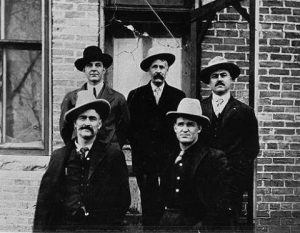 In the early years of Wyoming’s history, there was contention between cattle ranchers and sheep ranchers. The cattlemen thought the land was theirs, and they thought the sheepmen were invading their domain, and they weren’t going to allow it. Cattlemen were first to arrive in the Big Horn Basin, trailing in huge herds of cattle in 1879. They insisted their early arrival established a prior claim to the grass on the government land where their herds grazed. But the law said otherwise. The Cattle and Sheep Wars sprung from this dispute in the Western United States, but they were most common in Texas, Arizona, and the border region of Wyoming and Colorado. The cattlemen thought the sheep destroyed the public grazing lands, which they had to share on a first-come, first-served basis.
In the early years of Wyoming’s history, there was contention between cattle ranchers and sheep ranchers. The cattlemen thought the land was theirs, and they thought the sheepmen were invading their domain, and they weren’t going to allow it. Cattlemen were first to arrive in the Big Horn Basin, trailing in huge herds of cattle in 1879. They insisted their early arrival established a prior claim to the grass on the government land where their herds grazed. But the law said otherwise. The Cattle and Sheep Wars sprung from this dispute in the Western United States, but they were most common in Texas, Arizona, and the border region of Wyoming and Colorado. The cattlemen thought the sheep destroyed the public grazing lands, which they had to share on a first-come, first-served basis.
On April 2, 1909, the range war between the cattlemen and sheepmen in the Ten Sleep, Wyoming area came to a head, when a group of cattlemen decided that they were going to settle this battle once and for all. They headed to Spring Creek seven miles south of Ten Sleep, Wyoming where they knew of a camp. This was to be the last of the sheep raids in the Big Horn Basin. That fateful day, seven cattlemen attacked a sheep camp near  Spring Creek, just south of Ten Sleep, in the southern Big Horn Basin. When the raiders attacked, they killed three men, two of whom the burned to death in their sheep wagon. Then shooting the third man, the decided to kidnap two others. Then they killed the sheep dogs and dozens of sheep and destroyed thousands of dollars of personal property. It was the deadliest sheep raid in Wyoming history. I understand killing in war, but this was murder, and it was horrific!!
Spring Creek, just south of Ten Sleep, in the southern Big Horn Basin. When the raiders attacked, they killed three men, two of whom the burned to death in their sheep wagon. Then shooting the third man, the decided to kidnap two others. Then they killed the sheep dogs and dozens of sheep and destroyed thousands of dollars of personal property. It was the deadliest sheep raid in Wyoming history. I understand killing in war, but this was murder, and it was horrific!!
Wyoming was a territory from July 25, 1868 to July 10, 1890. Early on, there were more cattle ranches than sheep ranches, and the cattlemen felt like they had priority to public lands. Sheep raids began to plague Wyoming since the late 1890s, by which time sheep outnumbered cattle on Wyoming ranges. By 1909, at least six men had been killed, thousands of sheep had been slaughtered, and many thousands of dollars of property destroyed. Nevertheless, there had not been a single conviction for a crime committed during a sheep raid.
It’s really no surprise, given the rising numbers of sheep on the range in those years, that cattlemen were 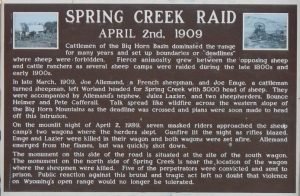 feeling pressured. By 1894 there were 1.7 million sheep in Wyoming and only 675,000 cattle. By 1909, the state’s peak year for sheep, there were more than six million sheep, and only 675,000 cattle. It makes sense that there were tensions, but that did not excuse the men on either side committing murder. Yes, Wyoming was a part of the wild west, and the lawmen were not always readily available, but that did not mean that these men should be able to kill the competition. We are ultimately, civilized people after all, even if we do live in the wild west. After the arrests for the Spring Creek Raid, the cattlemen we reluctant to raid the sheep camps, and with that, a horrific event of the old west passed into history.
feeling pressured. By 1894 there were 1.7 million sheep in Wyoming and only 675,000 cattle. By 1909, the state’s peak year for sheep, there were more than six million sheep, and only 675,000 cattle. It makes sense that there were tensions, but that did not excuse the men on either side committing murder. Yes, Wyoming was a part of the wild west, and the lawmen were not always readily available, but that did not mean that these men should be able to kill the competition. We are ultimately, civilized people after all, even if we do live in the wild west. After the arrests for the Spring Creek Raid, the cattlemen we reluctant to raid the sheep camps, and with that, a horrific event of the old west passed into history.

 My nephew, Dave Chase, joined our family when he married my niece, Toni. Dave has a dry sense of humor, and is quite practical, which is completely opposite of Toni, who is more emotional, than practical…according to her mom, Cheryl. Dave and Toni love to banter back and forth, and it keeps the whole family laughing. They tease each other, and it can be quite entertaining. Still, it is teasing, and these two really bring out the best in each other.
My nephew, Dave Chase, joined our family when he married my niece, Toni. Dave has a dry sense of humor, and is quite practical, which is completely opposite of Toni, who is more emotional, than practical…according to her mom, Cheryl. Dave and Toni love to banter back and forth, and it keeps the whole family laughing. They tease each other, and it can be quite entertaining. Still, it is teasing, and these two really bring out the best in each other.
When Toni and Dave met, Dave did not try to become a father to her son James, who has a dad. Wisely, Dave set out to become James’ friend. He won James over, and they are good friends. That has endeared Dave to the whole family! Dave also loves having 2 child pups. He loves taking them to the dog park in good weather especially, but they go no matter what the weather looks like…rain, shine, wind, or snow. If they can get to the dog park, Dave and the pups are going for a walk. Twice on the weekend days. Toni joins them on weekends. The whole family loves their dogs. The dogs must have the best of everything, including toys, beds, comfort, and…a maze in snowy weather to exercise and entertain themselves in! He loves to take the dogs kayaking too. No effort is to great to be undertaken for the sake of the dogs!
Dave has always been full of energy. My niece tells me that he hits the ground running the second his feet move from the bed to the floor. Dave hasn’t always loved the length and cold of the Wyoming winter, but he got a snow blower, and he loves to keep his driveway clear. Needless to say, when Dave awoke to some six to ten inches of snow on his birthday morning, he was excited and headed out to “play” with his machine…never mind 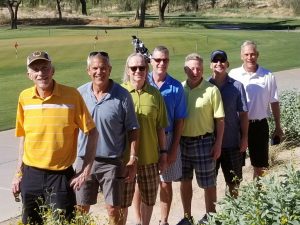 that it’s still coming down heavily. While his snow blower has helped with his winter blues, he has managed to find another release in the form of an annual golfing trip to Phoenix with the boys. It is a trip that he plans every year and brags that “the head count keeps on growing.” While Dave is there he always heads to Chase field to catch a game with his little brother Dan and nephew Ty, always in the hope of seeing the Dodgers, but this last April 2019 he had to settle for the Cubs.
that it’s still coming down heavily. While his snow blower has helped with his winter blues, he has managed to find another release in the form of an annual golfing trip to Phoenix with the boys. It is a trip that he plans every year and brags that “the head count keeps on growing.” While Dave is there he always heads to Chase field to catch a game with his little brother Dan and nephew Ty, always in the hope of seeing the Dodgers, but this last April 2019 he had to settle for the Cubs.
Dave and Toni took a trip…just the two of them, to Marco Island where they hit a different brewery every day, ate seafood every night, and had a great time all week including their last day there when they took a trip to Venice Beach. They learned how to shell for shark teeth at Venice Beach. They also “learned” how to lock their water, sunblock, beach towels and cell phones in the car while at Venice Beach, as well as how to lose their car keys in the ocean while at Venice Beach, and…they learned how to thank God for putting a little boy in the water that found their keys…30 yards from where they were looking for them.
They took a family trip to Escondido California, James got to go on this trip too. They all agreed that it was one of the best trips they have ever had. It exceeded all of their expectations. They went to the Miramar Air show, which made them feel very proud to be Americans, and to Cabrillo National Monument to name a few. Other than that trip, they took numerous overnight trips, saw a few concerts, watched the dodgers play, and of course, Dave made it to every home game for the Wyoming Cowboys.
Dave is good to his mother-in-law, Cheryl too. In winter, if the snow gets bad, Dave checks with her to see if anyone has shoveled her walk and if they haven’t, he will drive all the way across town to shovel for her! In the 
 spring and fall he, along with the rest of her family, cleans her yard so it’s ready for the coming season. These are kindnesses she appreciates so much more than words can say! Of course, mostly Cheryl loves that he takes care of Toni. He has always seen to it she has a good car to drive, a lovely home to live in, and that all her needs and wants are met. He’s practical and good in his heart! He considers what is needed in the family, and helps bring those things to pass. To Cheryl, these are excellent qualities! I agree. Today is Dave’s birthday. Happy birthday Dave!! Have a great day!! We love you!!
spring and fall he, along with the rest of her family, cleans her yard so it’s ready for the coming season. These are kindnesses she appreciates so much more than words can say! Of course, mostly Cheryl loves that he takes care of Toni. He has always seen to it she has a good car to drive, a lovely home to live in, and that all her needs and wants are met. He’s practical and good in his heart! He considers what is needed in the family, and helps bring those things to pass. To Cheryl, these are excellent qualities! I agree. Today is Dave’s birthday. Happy birthday Dave!! Have a great day!! We love you!!

 Seldom does it happen that money from a robbery is never recovered, but that is the case for approximately $28,000 in gold and silver coins, which have been missing for more than a century. The money came from the little known Wham Paymaster Robbery, which occurred near Pima, Arizona. Eight suspects were caught and tried for the crime, but in the end, they walked away free men. The circumstances of the robbery remain an unsolved mystery to this day. The robbery of US Army Paymaster, Major Joseph Washington Wham occurred on May 11, 1889 in the early morning hours. Wham was preparing to make the trip from Fort Grant to Fort Thomas to pay the soldiers’ salaries. The day before, he had distributed the pay to Fort Grant. That day, he was to pay the men at Fort Thomas, Camp San Carlos, and Fort Apache.
Seldom does it happen that money from a robbery is never recovered, but that is the case for approximately $28,000 in gold and silver coins, which have been missing for more than a century. The money came from the little known Wham Paymaster Robbery, which occurred near Pima, Arizona. Eight suspects were caught and tried for the crime, but in the end, they walked away free men. The circumstances of the robbery remain an unsolved mystery to this day. The robbery of US Army Paymaster, Major Joseph Washington Wham occurred on May 11, 1889 in the early morning hours. Wham was preparing to make the trip from Fort Grant to Fort Thomas to pay the soldiers’ salaries. The day before, he had distributed the pay to Fort Grant. That day, he was to pay the men at Fort Thomas, Camp San Carlos, and Fort Apache.
Wham, along with his clerk, William Gibbon, and Private Caldwell, his servant and mule tender, climbed into a canopied wagon driven by Buffalo Soldier, Private Hamilton Lewis for the 46 mile trip to Fort Thomas. The payroll Wham was still in possession of was more than $28,000 in gold and silver coins. It was locked in an oak strongbox in the wagon. Given the amount of money Wham was carrying, he was heavily escorted by nine Buffalo Soldiers of the 24th Infantry on horseback, as well as a wagon that carried two privates of the 10th Cavalry (also an African-American regiment) that was driven by a civilian employee of the Quartermaster Department. Everyone was heavily armed, except Wham, his clerk and the two drivers. An African-American female gambler named Frankie Campbell, joined them at the last minute. She wanted to ride along with them to be in Fort Thomas when the soldiers got paid…to stir up a game or two, I’m sure.
About 15 miles west of Pima in the Gila River Valley, just after midday, the caravan came to a stop. A large boulder was blocking the road, and the wagons were unable to get around it. The soldiers lay down their weapons in order to dislodge the large rock. They barely got started when a cry came from a ledge some 60 feet above on the adjacent hill, “Look out, you black sons of bitches!” and bullets began to hail down upon the soldiers. Three of the 12 mules pulling the wagons were killed and the other animals panicked, rearing and pulling both vehicles off the road. The soldiers ran for their guns and took cover to fight the barrage of bullets raining down on them from the hills. Sergeant Benjamin Brown was shot but continued to return fire with his revolver. Private James Young ran through heavy gunfire and carried Brown more than 100 yards to safety. Corporal Isaiah Mays then took command, ordering the entourage to retreat to a creek bed about 300 yards away, while Major Wham strongly protested. The battle continued to rage on for about a half an hour as the soldiers valiantly tried to protect the payload. However, eight of Wham’s eleven-man escort were severely wounded and the battle had become extremely one-sided. During all this, gambler, Frankie Campbell, who had been riding ahead of the caravan, had been thrown from her horse and had taken cover.
With the soldiers hidden, wounded, and severely out gunned, five bandits then made their way to the wagon. Once there, they cracked the strongbox with an ax, and carried off the U.S. Treasury sacks filled with the coins. The soldiers counted 12 outlaws, who made their escape. At about 3:00pm those, who could manage, made their way from the creek bed to the wagons. They spliced harnesses together, gathered some of the surviving mules, and finally made their way to Fort Thomas, arriving about 5:30pm. The soldiers left, Frankie Campbell to tend to the severely wounded, including Sergeant Benjamin Brown. These men would be brought in later. Amazingly, all of the soldiers would survive their wounds, so she must have done a good job with their care.
Amazingly, several of the bandits, who had not thought to cover their faces during the gun battle, were recognized and very soon arrested. US Deputy Marshal William Kidder Meade, and the Graham County Sheriff arrested 11 men, most of whom were citizens of Pima, Arizona. Seven were bound over for trial. The men were Gilbert Webb, the Mayor of Pima at the time. Webb was the suspected leader of the gang. Also arrested was his son, Wilfred. These men were already suspected of numerous thefts in the area. Along with the Webbs, brothers Lyman and Warren Follett, as well as David Rogers, Thomas Lamb, and Mark Cunningham, all of whom worked as cowboys for Gilbert Webb. Strangely, the men were charged with the robbery, but no one was ever charged with the shooting.
The trial in Federal Court in Tucson was held in November lasted 33 days. It was big news in the Southwest. With all the witnesses, I cant figure out how they could not be found guilty, but from the beginning, the trial involved major politics and infighting, including removing the original judge. In all, 165 witnesses testified at the trial, including five Buffalo Soldiers who identified three of the accused. Another witness testified that he had personally seen some of the men hiding the loot in a haystack and burning the US treasury sacks. Several other witnesses testified that they had seen members of the accused in the area of the ambush the day before…probably setting up their “hideouts” from which the ambush took place. Strangely, Frankie Campbell, who had stated she recognized several of the bandits, including the leader, Gilbert Webb, was never called to testify. The defense lawyer was the famed Marcus Aurelius Smith, and in the end all of the men were acquitted.
Afterward, it was widely claimed that political pressure from the acting governor allowed the thieves to go free. The entire case was a hotbed of religion, racism, and politics, as Pima, Arizona was founded as a Mormon Colony, of which Gilbert Webb was the mayor, one of the most influential men in the area, and came from a long line of pioneer Mormons. He was also known in the area as a generous man, providing jobs for struggling neighbors, extending credit, and providing provisions. Though most of the other accused men were not Mormons, they all lived in the Mormon colony, having many ties to the church through friends and relatives. Be it politics or religion, a great injustice was done that day. Many locals viewed the robbery and trial as an embarrassing disgrace to the town and its people, and to talk about it about might offend friends or neighbors, or bring shame upon the colony. Therefore, the robbery was kept largely under wraps. The locals called the robbers “Latter-Day Robin Hoods.”
In the meantime, Major Joseph Washington Wham, as the commanding officer, was held accountable for the loss of the money but was later absolved of any guilt. Two of the Buffalo Soldiers were awarded the Medal of Honor for their part in the gun battle with the bandits. Although shot in the abdomen, Sergeant Benjamin Brown continued the fight until he was further wounded in both arms. Corporal Isaiah Mays also received the Medal of Honor, as near the end of the gun battle, though shot in the legs, he “walked and crawled two miles to Cottonwood Ranch and gave the alarm.” Other Buffalo Soldiers cited for bravery in the incident received the Certificate of Merit. These included Hamilton Lewis, Squire Williams, George Arrington, James Wheeler, Benjamin Burge, Thomas Hams, James Young, and Julius Harrison of the 10th Cavalry and 24th Infantry. US 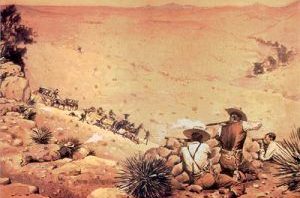
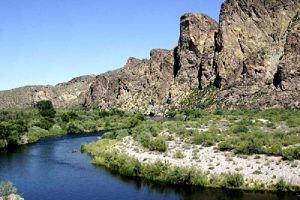 Deputy Marshal Meade, who would bring in the bandits, would say of the soldiers, “I am satisfied a braver or better defense could not have been made under like circumstances.” Throughout the years, the robbery has created a number of various treasure tales, suggesting that some of the coins are still hidden in the area somewhere. However; with all of the suspects set free, this would seem doubtful.
Deputy Marshal Meade, who would bring in the bandits, would say of the soldiers, “I am satisfied a braver or better defense could not have been made under like circumstances.” Throughout the years, the robbery has created a number of various treasure tales, suggesting that some of the coins are still hidden in the area somewhere. However; with all of the suspects set free, this would seem doubtful.
 My niece, Toni Chase is such a sweet natured person. She truly cares about the people around her…and especially their feelings. Toni and her husband, Dave Chase love to travel, going to many exotic places, as well as lots of football games. Dave is a football fanatic, so he and Toni have gone to many games, especially in Arizona…which would be a great place to go during the cold winter months in Wyoming. It’s also nice for Dave’s brother when they come to Arizona, because he gets to spend time with them.
My niece, Toni Chase is such a sweet natured person. She truly cares about the people around her…and especially their feelings. Toni and her husband, Dave Chase love to travel, going to many exotic places, as well as lots of football games. Dave is a football fanatic, so he and Toni have gone to many games, especially in Arizona…which would be a great place to go during the cold winter months in Wyoming. It’s also nice for Dave’s brother when they come to Arizona, because he gets to spend time with them.
Lately, however, they have been sticking a little bit closer to home. Dave’s dad has Alzheimer’s Disease or some type of dementia, and so he and Toni have spent quite a bit of time in Laramie, helping his mom and making sure that his dad knows how much they love him. The sad thing about dementia of any kind is that the recent past is forgotten, so if a patient is going to know you, you must go often. Having dealt with it myself, I know what they are going through, but they are kind-hearted, loving people, and they will get through this, and make a difference in his parents’ lives. Of course, while they are in Laramie, they managed to take in a few football games too.

When they are in town, Toni likes to be a homebody, when she isn’t working. They have two dogs that they absolutely love. Toni spoils the dogs, cooking for them just like they were her kids. When it snowed this last time, she and Dave went into the back yard and shoveled out a maze for the dogs. They just loved it. They ran back and forth excitedly, getting plenty of exercise for the day. My sister, Cheryl said it was really funny to watch. Most of us would get lost in a maze, but dogs can track their way out and back, so they had a blast. And of course, the snow wasn’t so deep that Toni and Dave couldn’t see over it…to rescue their babies, should they get lost.
For some time, Toni has run an eBay story, where she refurbishes items that anyone else would have thought junk. Now, however, she’s been phasing out her eBay store, because she is too busy with the dogs. My sister  fared pretty well from that, because she got to go to Toni’s house a few weeks ago to “shop” for anything she might like. Toni is such a giver. Cheryl came home with a purse full of costume jewelry and a dozen purses! She is very kind in sharing all the treasures she has accumulated over the past few years. And speaking of being a giver, her sister Liz Masterson is reminded of the first job Toni got as a teenager, her greatest joy was to take her siblings shopping. How many teenagers would do that? Most of them want the job to buy things for themselves, but not Toni. Oh sure she got things for herself too, but her first thought was of her siblings. She loves to make people smile. What a great way to be. Today is Toni’s birthday. Happy birthday Toni!! Have a great day!! We love you!!
fared pretty well from that, because she got to go to Toni’s house a few weeks ago to “shop” for anything she might like. Toni is such a giver. Cheryl came home with a purse full of costume jewelry and a dozen purses! She is very kind in sharing all the treasures she has accumulated over the past few years. And speaking of being a giver, her sister Liz Masterson is reminded of the first job Toni got as a teenager, her greatest joy was to take her siblings shopping. How many teenagers would do that? Most of them want the job to buy things for themselves, but not Toni. Oh sure she got things for herself too, but her first thought was of her siblings. She loves to make people smile. What a great way to be. Today is Toni’s birthday. Happy birthday Toni!! Have a great day!! We love you!!
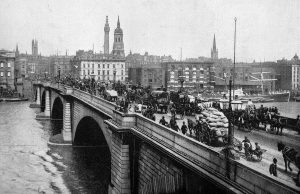
 They say that money can buy you just about anything…if you have enough of it. I suppose that in the area of material things, that might be true. Nevertheless, sometimes I wonder about the purchases made when people have money. Some purchases might be an interesting novelty, and might even have a purpose in the end, but they just seem like a rather extravagant, and yes, eccentric purchase. Nevertheless, for a price, some of the strangest purchases have been made.
They say that money can buy you just about anything…if you have enough of it. I suppose that in the area of material things, that might be true. Nevertheless, sometimes I wonder about the purchases made when people have money. Some purchases might be an interesting novelty, and might even have a purpose in the end, but they just seem like a rather extravagant, and yes, eccentric purchase. Nevertheless, for a price, some of the strangest purchases have been made.
I don’t know if Robert P. McCulloch was an eccentric millionaire, or if he just liked what he liked, but on April 18, 1968, he made a deal to buy the London Bridge, for 1 million dollars. He then had it disassembled from it’s former location spanning the River Thames in London, England, and reassembled in Lake Havasu City, Arizona. As the bridge was disassembled, each piece was numbered to aid in the re-assembly project. Then it was transported to Arizona to be re-assembled over the Colorado River, connecting an island there to the main part of Lake Havasu City. The bridge was originally built in the 1830s. The move was quite the undertaking.
Apparently, McCulloch was searching for a unique attraction for his city. His search eventually took him to London. By the early 1960s it was apparent that John Rennie’s 1831 “New” London Bridge was gradually sinking into the River Thames and the City of London Corporation decided that a new bridge was needed. Still, the bridge was a historic landmark, so rather than demolish the existing bridge, they decided to auction the historic landmark. I guess McCulloch wasn’t the only one with strange ideas. The Arizona bridge is a reinforced concrete structure that is covered in the original masonry of the 1830s bridge. To accomplish an exact duplicate, McCulloch had the exterior granite blocks from the original bridge numbered and transported to America to construct the present bridge in Lake Havasu City, to adorn a planned community he established in 1964 on the shore of Lake Havasu. The bridge was completed in 1971, complete with a canal, and it links an island in the Colorado River with the main part of Lake Havasu City.
Probably the most amazing thing about this is that Lake Havasu City can actually claim that they have the 
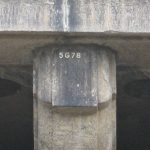 London Bridge there. Many people have made jokes about the intelligence of buyers, saying that if you’ll buy that, they have some ocean front property or even a bridge to sell you in Arizona. Well, I wouldn’t go for the ocean front property, which as we all know, doesn’t exist in Arizona, but the bridge is somewhat believable, although I doubt if this bridge is for sale, and if it was, I don’t know many people who could afford it. Nevertheless, it is a very unique landmark, and a very strange purchase, indeed.
London Bridge there. Many people have made jokes about the intelligence of buyers, saying that if you’ll buy that, they have some ocean front property or even a bridge to sell you in Arizona. Well, I wouldn’t go for the ocean front property, which as we all know, doesn’t exist in Arizona, but the bridge is somewhat believable, although I doubt if this bridge is for sale, and if it was, I don’t know many people who could afford it. Nevertheless, it is a very unique landmark, and a very strange purchase, indeed.

